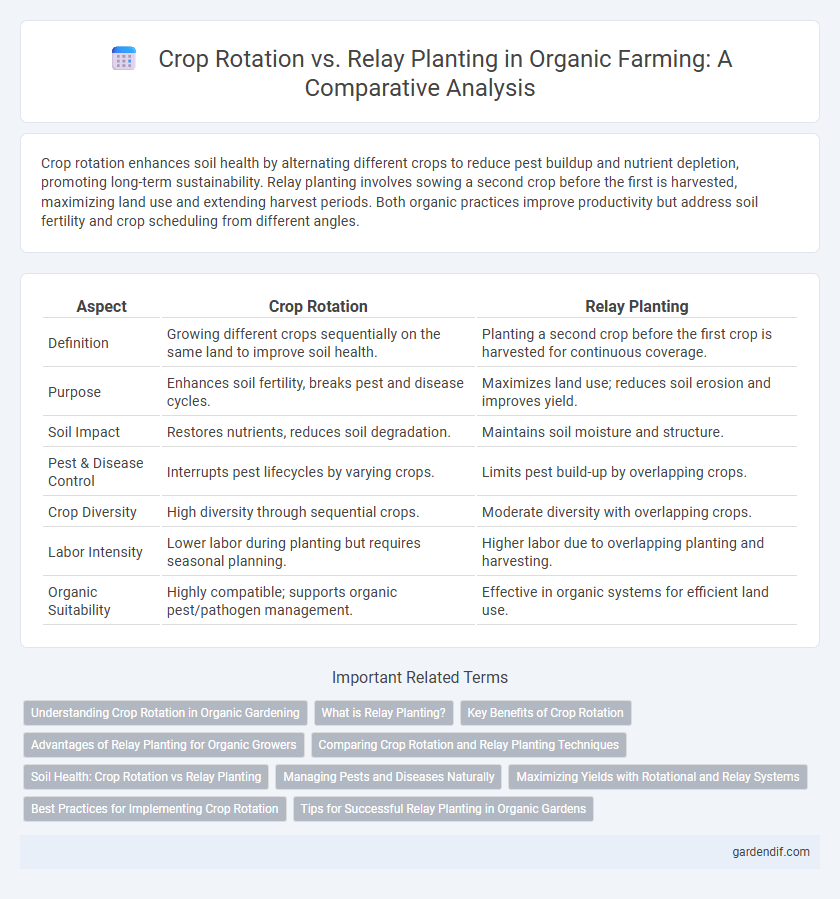
Crop rotation vs Relay planting Illustration
Crop rotation enhances soil health by alternating different crops to reduce pest buildup and nutrient depletion, promoting long-term sustainability. Relay planting involves sowing a second crop before the first is harvested, maximizing land use and extending harvest periods. Both organic practices improve productivity but address soil fertility and crop scheduling from different angles.
Table of Comparison
| Aspect | Crop Rotation | Relay Planting |
|---|---|---|
| Definition | Growing different crops sequentially on the same land to improve soil health. | Planting a second crop before the first crop is harvested for continuous coverage. |
| Purpose | Enhances soil fertility, breaks pest and disease cycles. | Maximizes land use; reduces soil erosion and improves yield. |
| Soil Impact | Restores nutrients, reduces soil degradation. | Maintains soil moisture and structure. |
| Pest & Disease Control | Interrupts pest lifecycles by varying crops. | Limits pest build-up by overlapping crops. |
| Crop Diversity | High diversity through sequential crops. | Moderate diversity with overlapping crops. |
| Labor Intensity | Lower labor during planting but requires seasonal planning. | Higher labor due to overlapping planting and harvesting. |
| Organic Suitability | Highly compatible; supports organic pest/pathogen management. | Effective in organic systems for efficient land use. |
Understanding Crop Rotation in Organic Gardening
Crop rotation in organic gardening involves systematically changing the types of crops grown in a specific area to improve soil health, reduce pest and disease buildup, and enhance nutrient availability. Unlike relay planting, which overlaps different crop cycles in a single growing season, crop rotation spans multiple seasons and focuses on alternating plant families to maintain ecological balance and soil fertility. This practice supports sustainable organic systems by minimizing the need for chemical inputs and promoting biodiversity.
What is Relay Planting?
Relay planting is an agricultural practice where a second crop is sown into a standing first crop before it is harvested, allowing both crops to grow simultaneously for a period. This method enhances land use efficiency, promotes biodiversity, and can improve soil health by maintaining continuous ground cover compared to traditional crop rotation. Relay planting supports organic farming by reducing soil erosion and minimizing the need for synthetic inputs through natural crop succession.
Key Benefits of Crop Rotation
Crop rotation enhances soil fertility and reduces pest and disease cycles by alternating different crops in the same field, which improves nutrient balance and soil structure. It promotes biodiversity, leading to healthier crops and higher yields without reliance on synthetic inputs. This sustainable practice decreases weed pressure and lowers the risk of soil erosion, supporting long-term organic farm productivity.
Advantages of Relay Planting for Organic Growers
Relay planting enhances soil health by maintaining continuous ground cover, reducing erosion, and improving nutrient cycling essential for organic farming. This method enables efficient use of growing space and time, increasing total yield without depleting soil resources or increasing chemical inputs. Organic growers benefit from reduced pest and disease pressure due to crop diversity and overlapping growth periods inherent in relay planting systems.
Comparing Crop Rotation and Relay Planting Techniques
Crop rotation involves systematically alternating different crops in the same field across seasons to improve soil health, reduce pest buildup, and enhance nutrient cycling. Relay planting overlaps growth periods of two or more crops in the same space, maximizing land use efficiency and reducing weed pressure during transitions. Both techniques promote sustainable organic farming but differ in timing and crop combination strategies, with crop rotation focusing on sequential diversity and relay planting emphasizing simultaneous growth phases.
Soil Health: Crop Rotation vs Relay Planting
Crop rotation enhances soil health by breaking pest and disease cycles while improving nutrient availability through diverse crop rooting patterns. Relay planting maintains continuous soil cover, reducing erosion and increasing organic matter, but may risk nutrient depletion if crops compete for resources. Combining both methods can optimize soil structure, fertility, and biological activity for sustainable organic farming systems.
Managing Pests and Diseases Naturally
Crop rotation disrupts pest and disease life cycles by alternating different crop families, reducing the buildup of specific pathogens and insect populations in the soil. Relay planting introduces successive crops in the same field within a growing season, encouraging biodiversity and continuous ground cover to suppress weeds and pests through natural predation. Both methods enhance soil health and promote ecological balance, minimizing reliance on chemical pesticides in organic farming systems.
Maximizing Yields with Rotational and Relay Systems
Crop rotation enhances soil fertility and pest management by alternating crops with complementary nutrient demands, leading to sustained high yields. Relay planting optimizes land use by overlapping crop growth stages, ensuring continuous harvest and reducing fallow periods. Combining rotational and relay systems maximizes productivity, improves soil health, and increases overall organic farm yield potential.
Best Practices for Implementing Crop Rotation
Implementing crop rotation involves systematically changing the types of crops grown in a specific field to improve soil health, reduce pest and disease cycles, and enhance nutrient utilization. Best practices include selecting diverse crop families, staggering planting schedules to optimize land use, and incorporating nitrogen-fixing legumes to boost soil fertility naturally. Monitoring soil conditions and adjusting rotation plans based on crop performance and pest pressures ensures sustainable organic farming outcomes.
Tips for Successful Relay Planting in Organic Gardens
Choose complementary crops with varied maturity rates to maximize space and soil health in organic gardens. Maintain consistent moisture and nutrient levels to support overlapping growth cycles without stressing plants. Monitor pest and disease pressures closely, rotating plant families to enhance biodiversity and reduce organic garden vulnerabilities.
Crop rotation vs Relay planting Infographic

 gardendif.com
gardendif.com